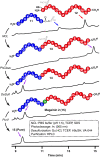Traceless native chemical ligation of lipid-modified peptide surfactants by mixed micelle formation
- PMID: 32493905
- PMCID: PMC7270136
- DOI: 10.1038/s41467-020-16595-w
Traceless native chemical ligation of lipid-modified peptide surfactants by mixed micelle formation
Erratum in
-
Author Correction: Traceless native chemical ligation of lipid-modified peptide surfactants by mixed micelle formation.Nat Commun. 2021 Apr 7;12(1):2210. doi: 10.1038/s41467-021-22508-2. Nat Commun. 2021. PMID: 33828105 Free PMC article. No abstract available.
Abstract
Biology utilizes multiple strategies, including sequestration in lipid vesicles, to raise the rate and specificity of chemical reactions through increases in effective molarity of reactants. We show that micelle-assisted reaction can facilitate native chemical ligations (NCLs) between a peptide-thioester - in which the thioester leaving group contains a lipid-like alkyl chain - and a Cys-peptide modified by a lipid-like moiety. Hydrophobic lipid modification of each peptide segment promotes the formation of mixed micelles, bringing the reacting peptides into close proximity and increasing the reaction rate. The approach enables the rapid synthesis of polypeptides using low concentrations of reactants without the need for thiol catalysts. After NCL, the lipid moiety is removed to yield an unmodified ligation product. This micelle-based methodology facilitates the generation of natural peptides, like Magainin 2, and the derivatization of the protein Ubiquitin. Formation of mixed micelles from lipid-modified reactants shows promise for accelerating chemical reactions in a traceless manner.
Conflict of interest statement
The authors declare no competing interests.
Figures





References
-
- Li X, Liu DR. DNA-templated organic synthesis: nature’s strategy for controlling chemical reactivity applied to synthetic molecules. Angew. Chem. Int. Ed. 2004;43:4848–4870. - PubMed
-
- Gorska K, Winssinger N. Reactions templated by nucleic acids: more ways to translate oligonucleotide-based instructions into emerging function. Angew. Chem. Int. Ed. 2013;52:6820–6843. - PubMed
-
- Orgel LE. Molecular replication. Nature. 1992;358:203–209. - PubMed
-
- von Kiedrowski G. A Self-replicating hexadeoxynucleotide. Angew. Chem. Int. Ed. 1986;25:932–935.
Publication types
MeSH terms
Substances
Grants and funding
LinkOut - more resources
Full Text Sources
Miscellaneous

